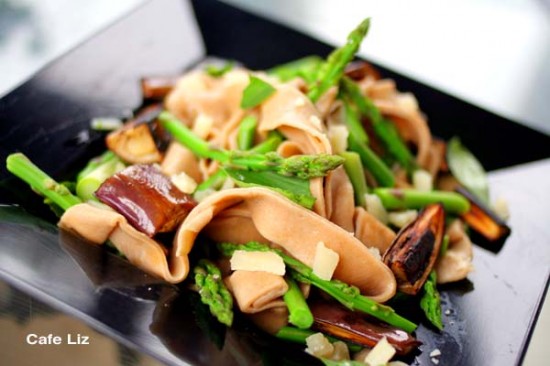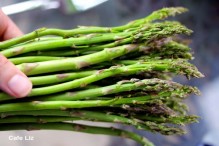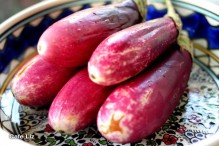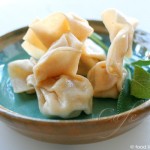
The weather is beautiful, and the asparagus stalks at the market are looking like the fresh, young shoots that they are. Simply beautiful. I could take a bunch of asparagus and put it in a vase in my living room, but then I’d have a vaseful of asparagus in my living room. But you get the idea.
In any case, asparagus this nice demands to be accompanied by other fine ingredients. When I decided I wanted to eat it with pasta, I knew the pasta had to be something interesting, preferably freshly made. So I made my own whole-wheat pasta. I wound up tossing it with the asparagus, seared miniature eggplants, Romano cheese, fresh basil and olive oil — nothing too complicated, just fresh, simple ingredients, which make for a wonderful, fresh-tasting dish.
I found a simple pasta recipe at SweetSmart, whose starting point was a Jamie Oliver recipe. Eggs, flour and no pasta machine? Sounded worth a try. Not surprisingly, it took me (and Eitan) some time to roll the pasta into a thin sheet, which was then rolled up and cut into strips, and it still came out thicker than I would have liked. I think I may have made my dough too dry. However, it still tasted like fresh pasta, which was the goal of this whole enterprise.
I also had a few miniature variegated eggplants in my fridge, so I decided to add them to the pasta dish as well. Why were they in my fridge? Because I saw them at the market and thought they were cute, even though I had no plans as to how to use them. They were not bitter at all — I tasted them before cooking to check — so a quick pan-fry produced good results.
The asparagus was probably fresh and tender enough to eat raw, but I decided to blanch it quickly so that it would be warm and slightly soft, and mesh better with the pasta and the seared eggplant. Taste your asparagus before cooking it — if it tastes good as is, you can choose to forgo cooking it. You could also consider briefly nuking it in the microwave — this study suggests it may retain more of its nutrients that way.
I tossed everything with my fresh, new olive oil. I have a 1-liter tin from Oded’s Masik in the Levinsky Street market, and they refill it every time I run out (for a fee, of course — 48 shekels a liter). I refilled it last week with an oil made from Barnea olives, which has a green, fruity flavor. Olive oil, like many other things, has the most flavor when it’s fresh.
For each serving:
1 miniature eggplant (about 150 grams)
150 grams asparagus
sprig of fresh basil
fresh Romano cheese — grated or finely chopped/crumbled
good-quality olive oil
salt
one portion of fettucine — based on the following recipe, or premade
For each serving of pasta:
3/8 cup white flour
3/8 cup whole wheat flour
1 egg
about 1 teaspoon water
Start by mixing the dough ingredients. Add the water slowly, until you have a pliable dough that you can knead. If it’s too hard, it’ll be hard to roll out; but if it’s too wet, it’ll be sticky. Wrap in plastic and let rest in the fridge for at least 30 minutes (I left mine overnight).
To form your pasta, roll out chunks of dough on a lightly floured surface, preferably until no more than a millimeter or two thick (at most). Roll up and cut the coil into discs. Each disc will unravel into a long, flat noodle. Set aside on a covered floured surface (such in the plastic wrap).
Now, start with the vegetables: Quarter the eggplants, and chop the quarters into chunks. Put a very small amount of oil in a frying pan. Remember, eggplants absorb oil like a sponge, and the goal is not to fry them. Put the eggplant chunks in the pan, cut-sides touching the metal, and put the flame on high. When the eggplants start to brown, stir them. It’s OK if the cut sides turn dark brown (but you don’t want them to become burnt). Add a little more oil if needed. Once the eggplants are soft, put them into a bowl and turn off the flame.
Meanwhile, boil water in a pot. Remove a small amount from the cut ends of the asparagus, and cut on a bias into short pieces. Blanch quickly in the boiling water (no more than 30 seconds; longer only if the asparagus is unusually hard) and remove with a slotted spoon. You could also microwave the asparagus for a moment.
Boil the pasta in the asparagus water — about 3-4 minutes for the above fresh pasta, or according to the instructions of the premade pasta of your choice. Once the pasta is chewy, drain it.
Toss the pasta with the asparagus, eggplant, ripped basil leaves, Romano cheese, salt and olive oil.
Parve variation: Drop the cheese.








